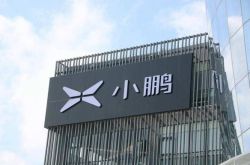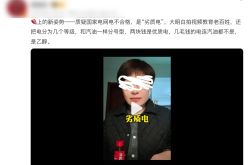Dark Side of the Moon: A Desperate Counterattack in the AI Arena
![]() 04/29 2025
04/29 2025
![]() 511
511
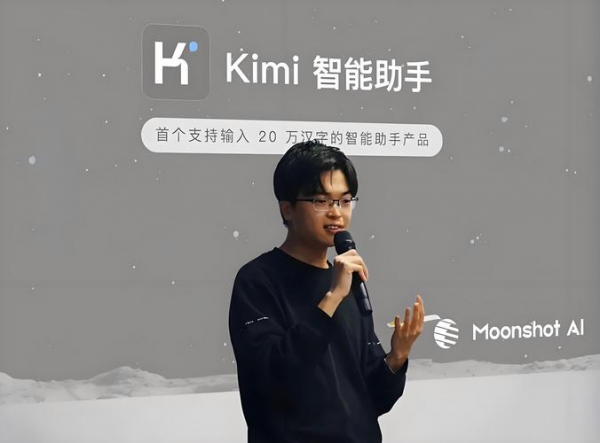
Author/Qingfu
Editor/Jiajia
Dark Side of the Moon has been quietly testing new content community features for its AI assistant Kimi in a closed beta. These features, including liking and commenting, are currently in grayscale testing with a select group of users to identify and rectify product issues before the final launch.
At this stage, most of the content within the Kimi community is generated by AI capturing hot topics and news from across the web, with a focus on inviting channel numbers from vertical fields such as technology and finance.
The introduction of these content community features represents not only a product innovation at the application level but also a strategic counterattack by Dark Side of the Moon against the formidable impact of DeepSeek, aiming to offset DeepSeek's technological advantage through innovative applications.
A year ago, Kimi, under Dark Side of the Moon, emerged as a dark horse in the AI large model C-end market through massive advertising. However, this dark horse was swiftly surpassed by DeepSeek, another formidable competitor. What surpassed Kimi was not the advertising war but rather the underlying AI technology that once gave Kimi its edge.
The current testing of content community features signals that Dark Side of the Moon is seeking an asymmetric advantage and catching up with DeepSeek through application innovations such as content.
[1] Glorious Moments
Among the "AI Six Little Dragons," Dark Side of the Moon was undoubtedly the most formidable company. In early 2024, Kimi achieved a closed beta milestone of processing 2 million words, equivalent to 4 million tokens. At that time, even the most capable long-text processors, like Google's Gemini 1.5 and Claude3, could only handle 1 million tokens, while the yet-to-be-launched GPT-4.5 Turbo specified a context window of 256,000 tokens.
Kimi was in the limelight, becoming an essential tool for functions such as thesis translation and understanding, legal issue analysis assistance, one-time invoice organization, and rapid API development documentation comprehension.
Dark Side of the Moon brought AI into reality, and its user base grew rapidly. According to data from aicpb.com, in February 2024, KimiChat received 3.05 million visits, a month-on-month increase of 107.6%, ranking third among AI large models in China in terms of visits, following Baidu's ERNIE Bot and Alibaba's Tongyi Qianwen.
The continuous growth in C-end user data even impacted Dark Side of the Moon's servers. Starting from March 20th, the company observed a continuous and abnormal increase in Kimi's system traffic, far exceeding the company's expected resource planning.
"We apologize for the continuous occurrence of the '429: engine is overloaded' error for our customers." Therefore, Dark Side of the Moon had to issue an announcement and conduct five capacity expansions to improve C-end user access to Kimi.
Kimi's popularity stemmed from the opportunities of the times. At that time, there was a scarcity of large C-end application models, as most domestic large models focused on the B-end market, serving businesses and merchants.
Kimi, with its innovative "unlimited context window" technology, achieved efficient parsing of million-word-level texts, effectively solving complex tasks in people's work and life. For example, in education, Kimi was included in the "Academic Integrity Toolkit" by Tsinghua and Peking Universities to guide students in the reasonable use of AI to assist in thesis writing. For self-media, online writers, and other groups, Kimi not only enabled data search but also addressed logical flaws and platform tone matching issues in long-content creation.
In fields such as academic research, legal contracts, and literary creation, Kimi could not only liberate human effort but also address the pain point of "taking things out of context" faced by traditional models at that time.
According to a research report from China Securities, "Kimi is expected to solve more complex application scenarios and may become a domestic C-end AI blockbuster application in a very short time due to its excellent performance in long texts." Kimi was regarded as one of the most promising AI star products.
However, Kimi was favored by research institutions and capital not only for its functionality but also for its operational strategy. While other large model vendors were still deepening their technology, Kimi conducted large-scale market promotion in 2024. According to Taimedia data, as of October 29th, the amount of advertising investment for Kimi Intelligent Assistant across the web that month reached 199 million yuan.
Taking advantage of the right time (the blank period in the C-end AI market) and the right place (high promotional costs), Kimi's user base doubled in a short period. Data shows that in October 2024, Kimi's monthly active users reached 10.06 million, and in November of the same year, its monthly active users reached 12.82 million, a month-on-month increase of 28%, ranking second in the industry after Baidu's Wenxin Yiyan.
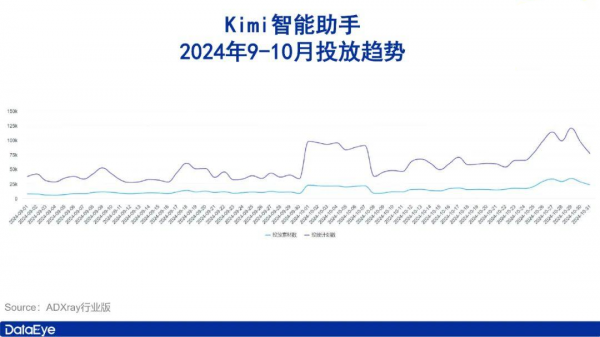
(Source: Internet)
Kimi was in the limelight at that time.
[2] Encountering a Lightning Strike
"Our current important goal is to continuously enhance the model's capabilities, explore the upper limits of intelligence, and bring a better experience to users. This is our first goal, which we call 'climbing stairs.' We hope to prioritize 'climbing stairs' more and not just 'enjoying the view.'"
Regarding the whirlwind Kimi created in the application market, Yang Zhilin, the founder of Dark Side of the Moon, had a clear understanding that only technological iteration could achieve growth.
Throughout 2024, Kimi underwent three major version upgrades in March, April, and November, covering improvements in response speed, search traceability, logic optimization, intent enhancement, information source analysis, chain thinking, and other capabilities.
In 2025, Kimi collided head-on with DeepSeek. At the beginning of 2025, with extremely low training costs and high performance, DeepSeek shocked the US AI large model industry, referred to domestically as a "national-level breakthrough," directly changing the development direction of AI large models—from stacking graphics cards to improve performance parameters to focusing on algorithms and costs themselves.
But the shock was not limited to foreign vendors like Google and OPEN AI; it also impacted domestic AI enterprises, with Kimi being the most severely affected. Unlike other large models that tend to focus on the B-end market, both Kimi and DeepSeek are aimed at C-end users. However, when DeepSeek's overseas influence spread to China, domestic users' curiosity soared, and they flocked to download DeepSeek.
Data shows that in January 2025, without any advertising investment, DeepSeek's user growth reached 125 million, with 100 million of those visits occurring within seven days. At that time, DeepSeek was called an "AI traffic black hole."
More importantly, in late March, Tencent Yuanbao announced a significant update: simultaneous access to the latest version of DeepSeek V3-0324 and the official version of the deep thinking model Hunyuan T1.
According to data, in the first quarter of this year, the total investment in AI product advertising across the industry was approximately 1.84 billion yuan, with Tencent Yuanbao accounting for up to 76%. In March alone, Tencent Yuanbao's advertising investment reached 1.1 billion yuan.
The high investment brought about rapid growth in user volume. According to QuestMobile data, in March, the monthly active user scales of DeepSeek and Tencent Yuanbao reached 190 million and 40 million, respectively, while Kimi's monthly active user count was only 18 million.
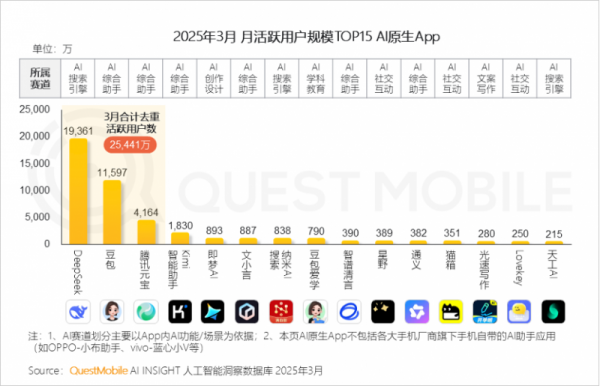
(Source: QuestMobile)
From the perspective of data growth changes, Kimi was the biggest victim of the "DeepSeek moment," and this unexpected competitor hindered Kimi's expansion in the C-end market.
"Smartphones are currently the best hardware carriers, but with the development of AI, will there be better hardware in the future? Will more modalities be integrated into them? We are very much looking forward to it," Yang Zhilin said, expressing his expectations for Kimi's future and believing that the seeds of change are quietly sprouting.
Indeed, the transformation of the times is budding, but the protagonist who unveiled the prelude to the new era was not Kimi but the previously unknown DeepSeek and the latecomer Tencent Yuanbao.
[3] Counterattack Ready
Under the impact of DeepSeek and Tencent Yuanbao, other large models among the "AI Six Little Dragons" have either joined forces with DeepSeek, such as Lingyi Wanwu developing enterprise-level products based on DeepSeek technology, or sought niche markets to form differentiated competition, such as Baichuan Intelligence focusing on the medical field and Jieyue Xingchen attempting to deeply bind with Geely Automobile to open up a new battlefield in the "AI + Automobile" field.
However, for Dark Side of the Moon, it is not a matter of dislocated competition because both are AI large models targeting C-end user groups, and their functional positioning is highly similar. This is a direct competition that is unavoidable and as sharp as the point of a needle against a wheat stalk.
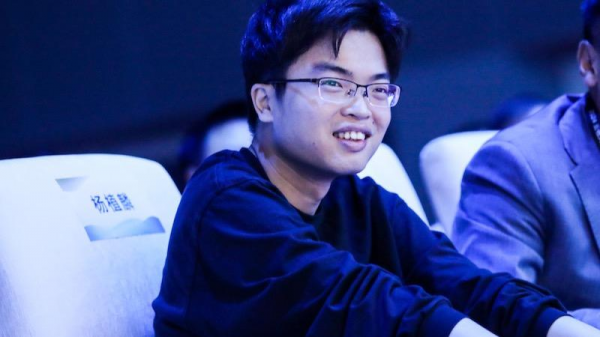
(Source: Internet)
It is precisely due to this urgency that we can see that Dark Side of the Moon has significantly accelerated its actions this year.
Firstly, it has reduced promotional investment and focused on improving model performance. In February of this year, Dark Side of the Moon announced price adjustments for nine model reasoning services it provides, including Kimi-latest-8k and moonshot-v1-8k. The input-output price was adjusted from the previous 12 yuan per million tokens to 2 yuan per million tokens for input and 10 yuan per token for output.
While significantly reducing prices, Dark Side of the Moon has also improved AI model performance. In February of this year, it launched "Moonlight," a 3 billion/16 billion parameter mixture-of-experts model (MoE) trained on Muon, using 5.7 trillion tokens to achieve better performance with lower floating-point operations (FLOPs).
Secondly, it has attempted application innovations to achieve differentiated competition through functional experience innovations at the product level. In addition to media exposure that Dark Side of the Moon's first content community product is undergoing grayscale testing, Dark Side of the Moon has also cooperated with mobile phone manufacturers such as Huawei. Currently, the Huawei Pura X phone is equipped with the "All-round AI Assistant" Kimi HarmonyOS version, supporting various commonly used functions such as deep search, photo question answering, assisted creation, translation, and document analysis.
These actions also show that Dark Side of the Moon's counterattack against DeepSeek focuses on application innovation at the product level, aiming to achieve dislocated competition in the C-end market with DeepSeek through the experience advantage brought by product innovation.
In fact, without DeepSeek, Dark Side of the Moon would be one of the most promising domestic AI large models. In the future, it has the potential to become a must-have app on mobile phones, like WeChat, Alipay, and JD.com, becoming an infrastructure for people's office and life in the AI era.
However, DeepSeek's emergence interrupted Kimi's C-end commercialization process. Where is Kimi's future path? Can the launch of AI products in the content community category form a counter-charge?
In the face of fierce AI competition, Kimi has switched lanes and begun to solve development challenges through application innovations, but everything still needs the test of time.
END




